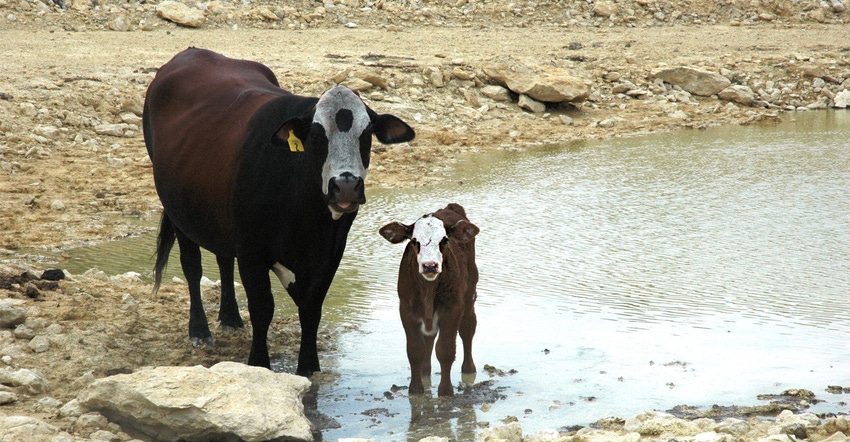July 19, 2022

With the heat wave pushing temperatures above 100 across the state, Texas livestock producers are reminded to maintain the water supplies and water quality their animals rely upon.
With most of the state currently experiencing drought conditions, the Texas A&M Veterinary Medical Diagnostic Laboratory, TVMDL, is encouraging cattle producers to be vigilant.
Water deprivation
To mitigate cattle losses due to water deprivation, ensure they have access to clean and plentiful water sources.
To remain healthy in hot weather, a 1,000-pound heifer may need to drink about 20 gallons daily. The lack of rain may also lead to far less forage growth. In normal years, green forage may provide some of the daily water requirements for a grazing cow. In drought years, forage becomes much drier and the amount of water available from forage will lessen.
To avoid water deprivation, ensure water is readily available to your cattle daily. Check the pumps that draw water from wells. Make sure troughs and tanks contain water. Ensure nipple waterers in barns are working properly.
Avoid holding cattle in pens that lack water sources for long periods, and do not work cattle in the heat of the day.
Ensure cattle know where to find water. Cattle are creatures of habit. If their preferred tank or trough dries up, animals may ignore other distant watering points in their pasture.
When introducing cattle to new pastures, drive the animals to the troughs or tanks. Make sure weaned calves know where to find water. Watch cattle to ensure they are drinking adequately.
Water/salt intoxication
When cattle become excessively dehydrated, sodium levels increase in all tissues, including the brain. If dehydrated cattle find water and drink too much too quickly, the liquid will rush to their brains. As pressure builds in the brains, cattle may develop instability or seizures, or may die from what is known as water/salt intoxication.
Salt intoxication does not mean the animal is getting an excessive load of salt, but rather the sodium concentration is increasing in the body because the animal is deprived of adequate water.
If cattle become dehydrated, they need to drink water immediately – but only in small amounts. If the trough is empty, put a few inches of water in the bottom.
Let all cattle drink at once to create competition for the water. Then repeat several times with 30 minutes between each watering until their thirst is satisfied. Monitor water intake and keep it gradual.
Poor water quality
Hot summer days take their toll on ponds and tanks. As water sources dwindle during a drought, water may become concentrated with salt and other inorganic materials.
Unpalatable water may cause cattle to avoid troughs or tanks, leading to deprivation and dehydration.
Test water for high concentrations of sodium, calcium, nitrates, magnesium salts and sulfates. If concentrations are high, new sources of fresh water must be provided.
Warm, stagnant water may also encourage the growth of blue-green algae, some of which are toxic. The algae often concentrate on the downwind side of a pond.
Dead rodents, birds or fish along the downwind side of a pond may indicate the presence of blue-green algae that could harm cattle. However, the first indication of blue-green algae could be one or more dead cattle.
Even during a drought, toxic weeds may thrive along the edges of a water source. Look along the shorelines of tanks and ponds for toxic weeds, such as small-headed sneezeweed or knotweed, and control grazing to avoid toxic weeds.
To learn more about testing options, visit TVMDL or call the College Station laboratory at 888-646-5623 and schedule a consultation with a veterinary diagnostician.
Read more about:
DroughtYou May Also Like




